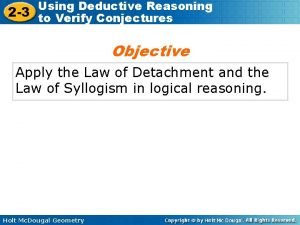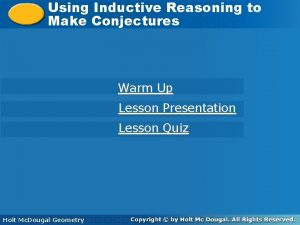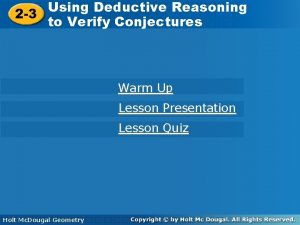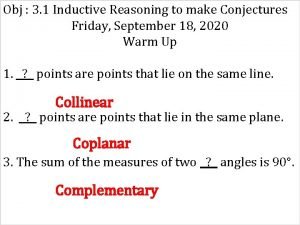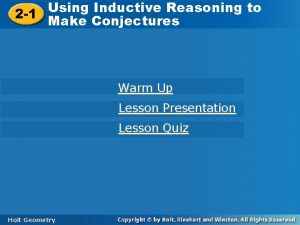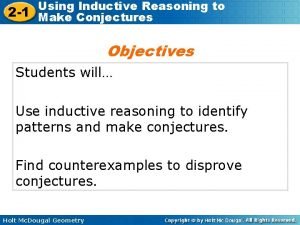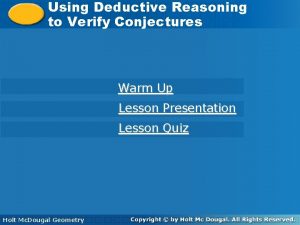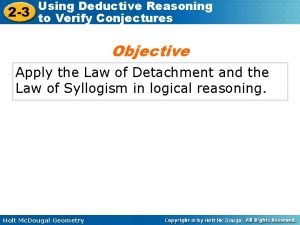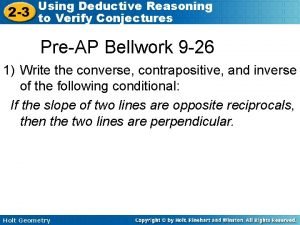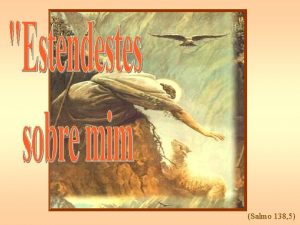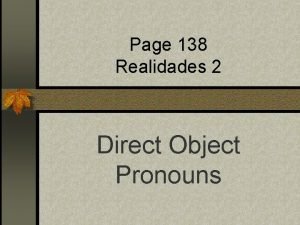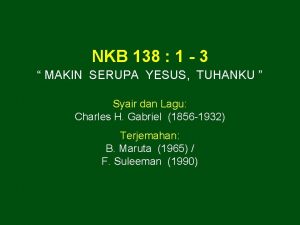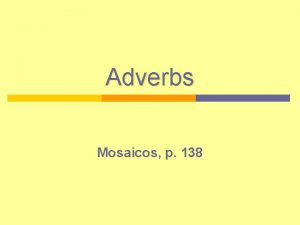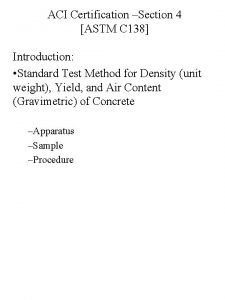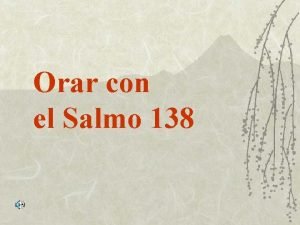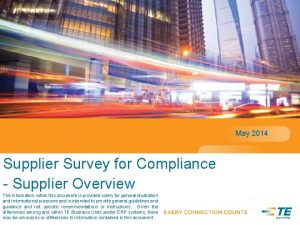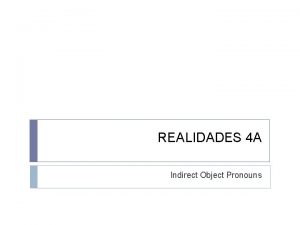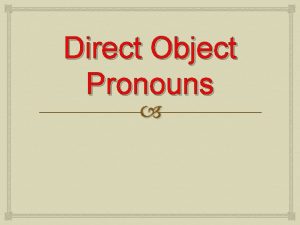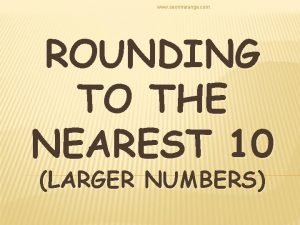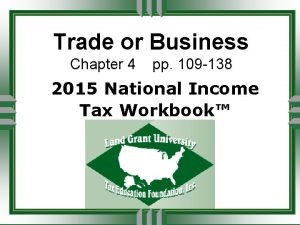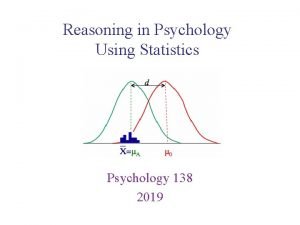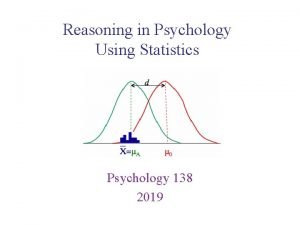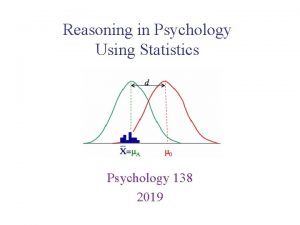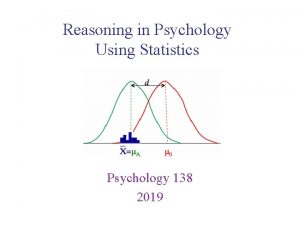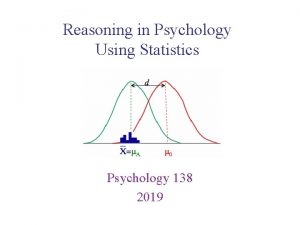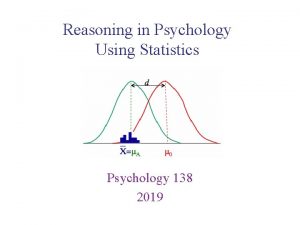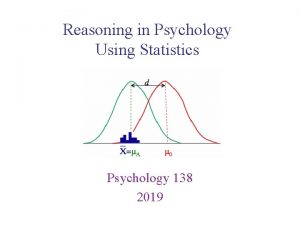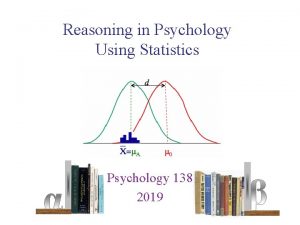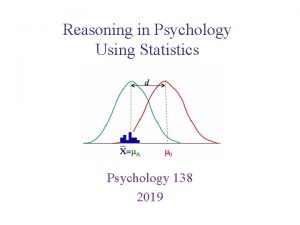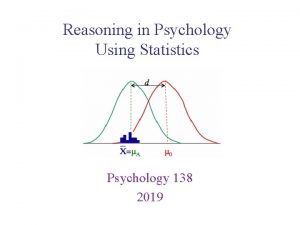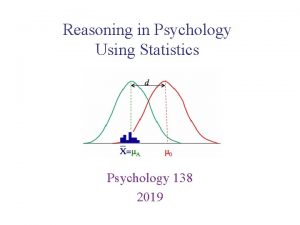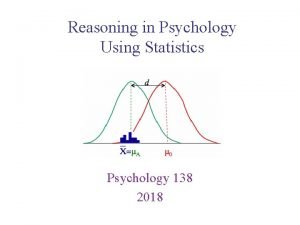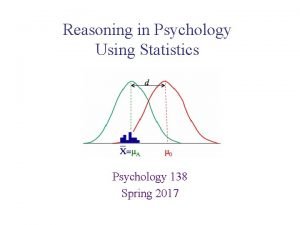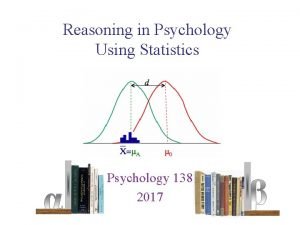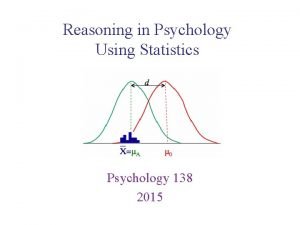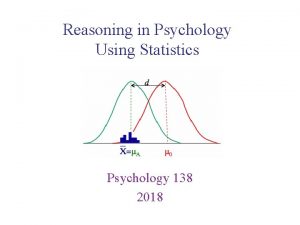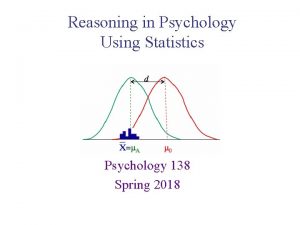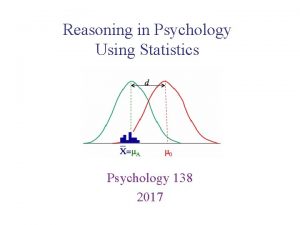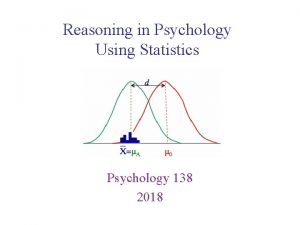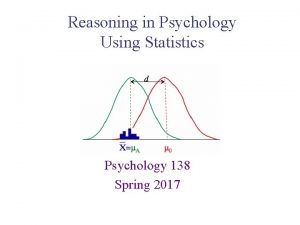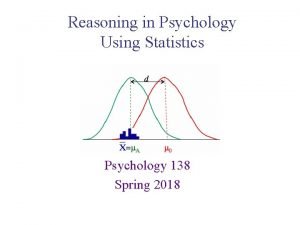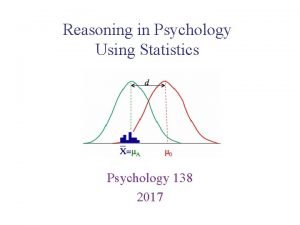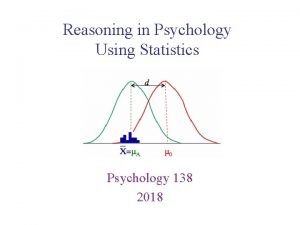Reasoning in Psychology Using Statistics Psychology 138 2019































- Slides: 31

Reasoning in Psychology Using Statistics Psychology 138 2019

• Many students found the lab exam too long/difficult to complete • Exam 3 extra credit opportunity (rather than a “curve”) for everybody (regardless of how you did on the exam) – May earn up to 15 points of extra-credit – This is a one time offer • late submissions will not be accepted – the due date is: ? ? Exam 3 Extra-credit Reasoning in Psychology Using Statistics

• 2 ½ weeks of new content – 3 more hypothesis tests – Estimation – Final Project Topics remaining Reasoning in Psychology Using Statistics

• Start working on your Final Projects soon (see link on syllabus page) – Due Wed, May 1 (uploaded to Reggie. Net Assignment: Final Project) – Lab instructor assign a case in lab Monday – Make sure to download: • Your case datafile • Expectations – Write in sentences and paragraphs. Don’t just copy and paste SPSS; also interpret the output. There is a “sample paper” provided. • Checklist – Need to run SPSS • During lab after finish lab exercise or Milner lab or DEG 17 (PRC) – PRC hours: https: //psychology. illinoisstate. edu/prc/hours/ Final Projects Reasoning in Psychology Using Statistics

• Changing focus – Looking for differences between groups: ONE VARIABLE – Looking for relationships between TWO VARIABLES Decision tree Reasoning in Psychology Using Statistics

• Changing focus – Looking for relationships between variables (not looking for differences between groups) Describing the – Today’s topic: Pearson’s correlation strength of the Relationship between variables Quantitative variables Decision tree Reasoning in Psychology Using Statistics Two variables relationship

• Relationships between variables may be described with correlation procedures Suppose that you notice that the more you study for an exam, the better your score typically is. – This suggests that there is a relationship between: study time test performance 115 mins Relationships between variables Reasoning in Psychology Using Statistics

• Relationships between variables may be described with correlation procedures To examine this relationship you should: • Make a Scatterplot Y 6 5 4 3 2 1 1 2 New 3 4 5 • Compute the Correlation Coefficient 6 X • Determine whether the correlation coefficient is statistically significant - hypothesis testing Relationships between variables Reasoning in Psychology Using Statistics

r = -1. 0 perfect negative corr. Reject H 0 -1. 0 rcritical r = 1. 0 perfect positive corr. r = 0. 0 no relationship Fail to Reject H 0 0. 0 Reject H 0 rcritical +1. 0 The farther from zero, the stronger the relationship How strong a correlation to conclude it is beyond what expected by chance? Review & New Reasoning in Psychology Using Statistics

Suppose that you notice that the more you study for an exam (X= hours of study), the better your exam score typically is (Y = exam score). Is there a statistically significant relationship between these variables (alpha = 0. 05)? X Y A 6 6 B 1 2 C 5 6 D 3 4 E 3 2 Example Reasoning in Psychology Using Statistics Y 6 5 4 3 2 1 1 2 3 4 5 6 X

• Pearson product-moment correlation – A numeric summary of the relationship degree to which X and Y vary together degree to which X and Y vary separately r= Step 3 Step 1 Step 2 • Step 1: compute Sum of the Products (SP) • Step 2: SSX & SSY • Step 3: compute r Review: Computing Pearson’s r Reasoning in Psychology Using Statistics

Suppose that you notice that the more you study for an exam (X= hours of study), the better your exam score typically is (Y = exam score). Is there a statistically significant relationship between these variables (alpha = 0. 05)? X Y A 6 6 2. 4 B 1 2 C 5 D 3 E 5. 2 1. 96 2. 0 4. 0 2. 8 -0. 6 0. 36 0. 0 -0. 6 0. 0 0. 36 15. 20 -2. 0 SSX 0. 0 4. 0 16. 0 1. 2 14. 0 6 1. 4 4 Example Reasoning in Psychology Using Statistics 4. 8 -2. 0 -2. 6 3 2 mean 3. 6 4. 0 2. 0 4. 0 5. 76 6. 76 Step 2 SSY SP Step 1

Suppose that you notice that the more you study for an exam (X= hours of study), the better your exam score typically is (Y = exam score). Is there a statistically significant relationship between these variables (alpha = 0. 05)? X Y A 6 6 B 1 2 C 5 6 D 3 4 E 3 2 Step 3 15. 20 Example Reasoning in Psychology Using Statistics SSX 16. 0 Step 2 SSY 14. 0 SP Step 1

Suppose that you notice that the more you study for an exam (X= hours of study), the better your exam score typically is (Y = exam score). Is there a statistically significant relationship between these variables (alpha = 0. 05)? • Appears linear • Positive relationship • Fairly strong relationship Y X Y A 6 6 B 1 2 C 5 6 D 3 4 E 3 2 6 5 4 3 2 1 1 2 3 Example Reasoning in Psychology Using Statistics 4 5 6 X • . 898 is far from 0, near +1 • Fairly strong, but stronger than you would expect by chance?

Suppose that you notice that the more you study for an exam (X= hours of • Hypothesis testingis (Y = exam score). Is study), the better your exam score typically there a statistically significant between testing these variables – Corerelationship logic of hypothesis (alpha = 0. 05)? • Considers the probability that the result of a study could have come about if no effect (in this case “no relationship”) • If this probability is low, then the scenario of no effect (relationship) is rejected Y X Y A 6 6 B 1 2 C 5 6 D 3 4 E 3 2 6 5 4 3 2 1 1 2 3 Example Reasoning in Psychology Using Statistics 4 5 6 X • Fairly strong, but stronger than you would expect by chance?

Suppose that you notice that the more you study for an exam (X= hours of study), the better your exam score typically is (Y = exam score). Is there a statistically significant relationship between these variables (alpha = 0. 05)? X Y A 6 6 B 1 2 C 5 6 D 3 4 E 3 2 Example Reasoning in Psychology Using Statistics • • Step 1: State your hypotheses Step 2: Set your decision criteria Step 3: Collect your data Step 4: Compute your test statistics • Step 5: Make a decision about your null hypothesis

– Step 1: State your hypotheses: as a research hypothesis and a null hypothesis about the populations • Null hypothesis (H 0) • There are no correlation between the variables (they are independent) ρ= • Research hypothesis (HA) • Generally, the variables correlated (they are not independent) ρ≠ Note: symbol ρ (rho) is actually correct, but rarely used Hypothesis testing with Pearson’s r Reasoning in Psychology Using Statistics

– Step 1: Hypotheses Two -tailed Hypothesize that variables are correlated (either direction) H 0 : ρ = HA: ρ ≠ Hypothesis testing with Pearson’s r Reasoning in Psychology Using Statistics

– Step 1: Hypotheses Two -tailed Hypothesize that variables are correlated (either direction) One -tailed Hypothesize that variables are: Negatively correlated Positively correlated H 0 : ρ = H 0 : ρ ≥ ρ < HA: ρ ≠ HA: ρ < ρ> Hypothesis testing with Pearson’s r Reasoning in Psychology Using Statistics

Suppose that you think that the more you study for an exam (X= hours of study), the better your exam score typically is (Y = exam score). You decide to test whethere is any statistically significant relationship between these variables (alpha = 0. 05). • Step 1 2 -tailed X Y A 6 6 B 1 2 C 5 6 D 3 4 E 3 2 Example: New Reasoning in Psychology Using Statistics There is no correlation between the study time and exam performance H 0 : ρ = There is a correlation between the study time and exam performance HA: ρ ≠

– Step 1: Hypotheses – Step 2: Criterion for decision • Alpha (α) level as guide for when to reject or fail to reject the null hypothesis. – Based on probability of making type I error Hypothesis testing with Pearson’s r Reasoning in Psychology Using Statistics

You decide to test whethere is any statistically significant relationship between these variables (alpha = 0. 05). 2 -tailed X Y A 6 6 B 1 2 C 5 6 D 3 4 E 3 2 • Step 2 Example: New Reasoning in Psychology Using Statistics H 0 : ρ = α = 0. 05 HA: ρ ≠

– Step 1: Hypotheses – Step 2: Criterion for decision – Steps 3 & 4: Sample & Test statistics • Descriptive statistics (Pearson’s r) • Degrees of freedom (df): df = n – 2 üUsed up one for each variable for calculating its mean üNote that n refers to number of pairs of scores, as in relatedsamples t-tests Hypothesis testing with Pearson’s r Reasoning in Psychology Using Statistics

You decide to test whethere is any statistically significant relationship between these variables (alpha = 0. 05). 2 -tailed X Y Y A 6 6 B 1 2 C 5 6 6 5 4 3 2 1 D 3 4 E 3 2 HA: ρ ≠ α = 0. 05 • Steps 3 & 4 r = 0. 898 1 2 3 4 5 6 X Example: New Reasoning in Psychology Using Statistics H 0 : ρ = df = n - 2 = 5 - 2 =3

– Step 1: Hypotheses – Step 2: Criterion for decision – Steps 3 & 4: Sample & Test statistics – Step 5: Compare observed and critical test values – Use the Pearson’s r table (based on t-test or r to z transformation) Note: For very small df, need very large r for significance Critical values of r (rcrit) Hypothesis testing with Pearson’s r Reasoning in Psychology Using Statistics

Suppose that you notice that the more you study for an exam (X= hours of study), the better your exam score typically is (Y = exam score). Is there a statistically significant relationship between these variables (alpha = 0. 05)? 2 -tailed H 0: ρ = HA: ρ ≠ X Y df = n - 2 = 3 α = 0. 05 A 6 6 B 1 2 C 5 6 D 3 4 E 3 2 Y • Step 5 6 5 4 3 2 1 From table 1 2 3 4 5 6 X Example: New Reasoning in Psychology Using Statistics rcrit = ± 0. 878

– Step 1: Hypotheses – Step 2: Criterion for decision – Steps 3 & 4: Sample & Test statistics – Step 5: Compare observed and critical test values & Make a decision about H 0 & Conclusions 1 -tailed case when H 0: ρ > 0 rcritical -1. 0 Fail to Reject H 00. 0 Reject H 0 +1. 0 Hypothesis testing with Pearson’s r Reasoning in Psychology Using Statistics

The observed correlation is farther away from zero than the rcritical so we reject Suppose that you. Hnotice that the more you study for an exam (X= hours of 0 study), the better your exam score typically is (Y = exam score). Is there a statistically significant relationship between these variables -1. 0 0. 0 +1. 0 (alpha = 0. 05)? 2 -tailed H 0: r = HA: r ≠ X Y df = n - 2 = 3 α = 0. 05 A 6 6 B 1 2 C 5 6 D 3 4 E 3 2 Y • Step 5 6 5 4 3 2 1 1 2 3 4 5 6 X • Reject H 0 • Conclude that the correlation is not equal to 0 “There is a significant positive correlation between study time and exam performance” Example: New Reasoning in Psychology Using Statistics rcrit = ± 0. 878

Generally, it is considered best to have at least 30 pairs of scores to conduct a Pearson’s r analysis Minimum N = 30, df = 28, rcrit =. 30 Best Practice Reasoning in Psychology Using Statistics

SPSS: HGT. SAV Height by Weight, N = 40 Note that significance is expressed the same as previously r (38) =. 794, p <. 001 What is p for 1 -tailed test? For df = 38, α =. 05, 2 tailed, rcrit =. 31 Using Correlation in SPSS Reasoning in Psychology Using Statistics

• In labs: – Hypothesis testing with correlation (by hand with SPSS) • Questions? Wrap up Reasoning in Psychology Using Statistics
 Definition of inductive method
Definition of inductive method Examples of deductive reasoning
Examples of deductive reasoning Deductive method
Deductive method Inductive and deductive reasoning geometry examples
Inductive and deductive reasoning geometry examples Every quiz has been easy. therefore, the test will be easy.
Every quiz has been easy. therefore, the test will be easy. Patterns and inductive reasoning
Patterns and inductive reasoning Reasoning example
Reasoning example Introduction to statistics what is statistics
Introduction to statistics what is statistics 2-3 using deductive reasoning to verify conjectures
2-3 using deductive reasoning to verify conjectures Using inductive reasoning to make conjectures answers
Using inductive reasoning to make conjectures answers 2-3 using deductive reasoning to verify conjectures
2-3 using deductive reasoning to verify conjectures Using inductive reasoning to make conjectures
Using inductive reasoning to make conjectures 2-1 using inductive reasoning to make conjectures
2-1 using inductive reasoning to make conjectures Using inductive reasoning to make conjectures
Using inductive reasoning to make conjectures Using deductive reasoning to verify conjectures
Using deductive reasoning to verify conjectures Using deductive reasoning to verify conjectures
Using deductive reasoning to verify conjectures Using deductive reasoning to verify conjectures
Using deductive reasoning to verify conjectures Salmo
Salmo Direct object pronouns p 138
Direct object pronouns p 138 Nkb 194
Nkb 194 Hpd 136 uitm
Hpd 136 uitm Direct object pronoun of la mochila
Direct object pronoun of la mochila Adverbs with v
Adverbs with v Astm 138
Astm 138 Psalms 138:1-3
Psalms 138:1-3 Tiempo de orar salmo 138
Tiempo de orar salmo 138 Tec-138-702
Tec-138-702 Pg 138
Pg 138 Capitulo 4a indirect object pronouns (p. 199)
Capitulo 4a indirect object pronouns (p. 199) Direct object pronouns spanish
Direct object pronouns spanish Round 2 617 to the nearest ten
Round 2 617 to the nearest ten 109+138
109+138








